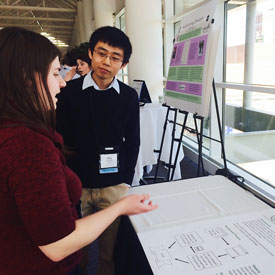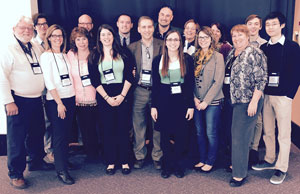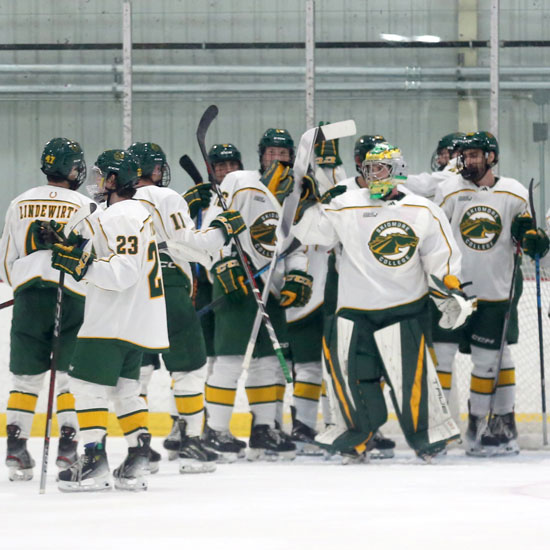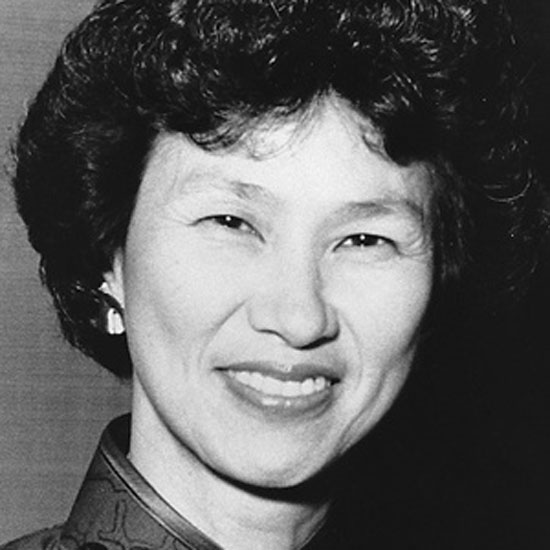Words vs. images: Which fosters better learning?

Yang Yu answers questions about his work at
conference.
It’s said that some people are “visual learners.” Computer science major Yang Yu ’15 used a yearlong apprenticeship in Skidmore’s academic technologies office to develop a system for testing visual learning vs. text-based learning. And his early results might surprise you.
But most important was his own learning, both about video vs. text and about taking part in the professional information-technology community by presenting at a major conference of the Educause Northeast Regional Computing Program in April. He was among four students who shared their work at NERComp, thanks to a successful proposal by their mentors at member colleges of the New York 6 consortium. “It felt good that people were interested in my work,” Yu says. “Even after I set my poster aside and the other apprentices were showing theirs, people kept asking me questions about my project.”
The NY6 colleges developed the Instructional Technology Apprenticeship Program in 2013 to help students blend liberal arts with hands-on practice in educational computing. Each college typically has one ITAP apprentice per year, paying a stipend that allows the student to forego a different campus job and devote 10–15 hours per week to the apprenticeship. After a kickoff meeting where all six colleges’ apprentices get to know each other, they collaborate through webinars and other online tools. The apprentices are each mentored by IT staff at their colleges, observing and practicing the integration of technology into teaching and learning.
Yu’s primary mentor in Skidmore’s IT office has been Ben Harwood, along with Alex Chaucer, who helped start ITAP and co-directs it with a Union College counterpart. Beth DuPont directs their office.
The ITAP curriculum covers instructional design, instructional technology, and a final project. “Having this year’s projects accepted for presentation at NERComp was impressive,” Harwood says. “It’s a high-profile conference where IT people from all the big schools in the Northeast convene for networking and workshops.” He adds that he’s seen apprentices being recruited by IT firms. Chaucer says, “The apprenticeships and attending the conference—especially presenting at it—are really paraprofessional experiences.”
Chaucer and Harwood like to find apprentices early in their college careers, because after they complete ITAP they can move into a fellows program. Angelo Gonzalez ’15, Skidmore’s first NY6 ITAP apprentice in 2013, was a fellow this year. Chaucer reports, “The fellows taught the apprentices how to create a good poster and present it for an audience. They developed an online module for them to work through—a great learning opportunity for both groups.”
For Yu, ITAP dovetailed with his senior thesis in computer science. Having researched facial recognition software with Professor Mike Eckmann, he also got help from Harwood—whom he calls “a really great mentor”—to develop the learning preference assessment. Yu explains, “We came up with a way to monitor people while they learn. They watch a visual presentation or they read a text, then they take a quiz about it, and the computer monitors how often they need to look back at the material as they take the quiz.” His system assigns a score based on the number of look-backs and the time required to get all the quiz answers correct. He says, “Users mentioned that videos contained too much information that often is distracting,” and the monitoring confirmed that “video materials are harder to digest than text materials.”
At NERComp, when he wasn’t fielding questions about his poster, Yu enjoyed seeing the other presenters’ work. A computing manager from American International College had a tele-health project using video, and Yu says, “I suggested the use of augmented vision, maybe with Google Glass, and we got to discuss that. It was a really good experience.”

Apprentices, fellows, and the instructional technologist and IT
directors from the NY6 schools.
Sadly for Harwood and Chaucer, Yu is graduating in May, earning his degree in just three years. But he hopes that a future ITAP apprentice might continue his work. He’d like the system to use one computer screen, for example, instead of needing a second one for monitoring look-backs at the original materials: “With facial tracking, rather than just recognition, we could monitor eye movements to determine which parts of the screen the user is looking at.” He’s leaving behind his code, for others to build on.
Yu already has a job offer in China. He says he wants “to combine the mind-broadening of the liberal arts with some hands-on work, to help me decide which areas of computer science to specialize in when I go to grad school.”
The NY6 Liberal Arts Consortium, established through an Andrew W. Mellon Foundation grant to foster collaboration and resource-sharing, includes Colgate University, Hamilton College, Hobart and William Smith Colleges, Skidmore College, St. Lawrence University, and Union College.


